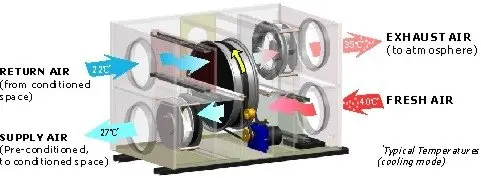
The axis of the rotor is located parallel to, and on the partition between, the two ducts. Working independently of any normal heating. It moves the stale air through the innumerable number of small pipes while drawing in cold air from outside via the other ducts.

The BryXchange rotor has a fluted media, fabricated with material having a high heat carrying capacity, which rotates between two side-by-side ducts: on a low temperature supply air duct, the other a hot temperature exhaust air duct. These valves filter the air supplied in and out of each room, finally progressing to the heat exchanger, which is commonly known as the brain of the heat recovery system. As the rotor slowly rotates, sensible heat of temperature exhaust air is carried over by the rotor to the low temperature supply air.ĭesign and Structure of BryXchange Air to Air Rotary Heat Exchanger Principle of working for BryXchange Air to Air Rotary Heat ExchangerīryXchange rotor is installed between the high temperature exhaust air and supply air stream. Through BryExchange this sensible waste energy can be recovered from the exhaust air and transferred to the low temperature supply air with efficiency of upto 75% energy. Considerable high temperature air is generated in kilns, ovens, furnaces etc. The recovered heat can be redirected for various heating applications, which saves energy while maintaining conditions.Bry-Air’s BryXchange is an air to air rotary heat exchanger which recovers energy from high temperature exhaust air.

When there is a simultaneous need for chilled water and hot water, these chillers have the capability to operate in heat recovery mode. How It Worksĭuring cooling only operation, the chiller produces a controlled source of chilled water leaving the evaporator while dissipating heat through the condenser and ultimately to the environment. Carrier chillers with heat reclaim capabilities can do just that produce chilled water controlled to the necessary temperature while generating hot water as a by-product of the chilled water system.


There is a more efficient means of generating hot water through the application of chiller systems with heat reclaim capabilities. If a more efficient means of providing heat could be implemented it would represent a tremendous opportunity to reduce energy consumption in buildings and thus reduce total energy consumption. Of the energy consumed in commercial buildings, 43 percent is used for space and water heating. Buildings are responsible for 40 percent of total energy consumption.


 0 kommentar(er)
0 kommentar(er)
